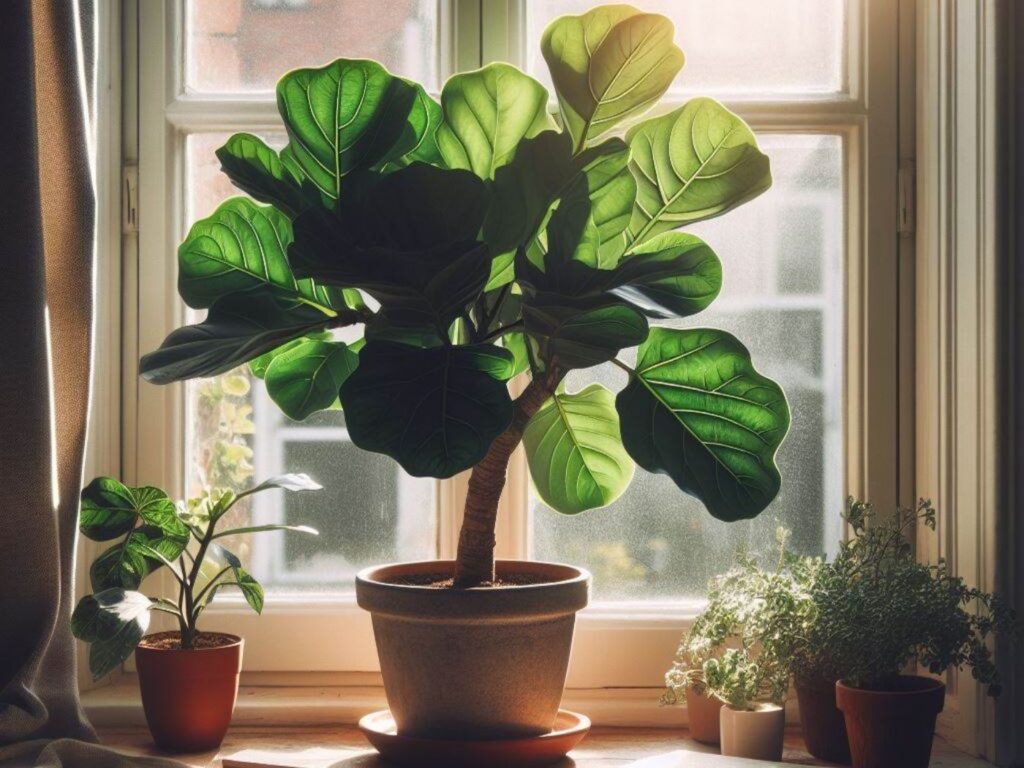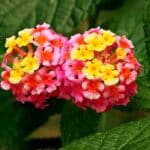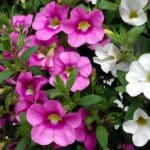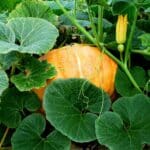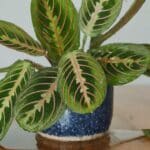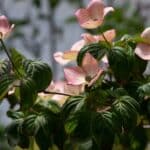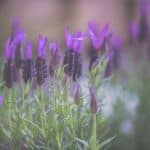Noticing yellow leaves on your fiddle leaf fig can be disheartening. This lush, sculptural plant has soared in popularity, gracing stylish interiors with its glossy, violin-shaped leaves.
Yet, when those leaves start turning yellow, it’s a clear sign that your plant is in distress. Understanding the root cause is crucial to restoring your fiddle leaf fig to its vibrant self.
Fortunately, you’re not alone in this. Yellow leaves can result from several common issues, ranging from watering habits to light exposure. Identifying and addressing these factors can not only revive your plant but also enhance your green thumb skills.
Let’s dive into the world of fiddle leaf fig care, where you’ll learn how to troubleshoot this issue and prevent it from happening again. Your journey to becoming a fiddle leaf fig whisperer starts here.
Understanding Fiddle Leaf Fig Yellow Leaves
Diving into the care of fiddle leaf figs, it’s apparent that yellow leaves can be a sign of stress in these plants. Identifying the cause is key to bringing them back to health. Let’s explore further.
Causes of Yellowing Leaves
Yellow leaves can alarm any plant owner, but they’re your fig’s way of saying, “Hey, something’s off!” Several factors contribute to this issue:
- Watering Issues: Too much or too little, either way, your plant’s not happy. If the soil feels like a wrung-out sponge, you’re on the right track. Otherwise, it’s time to adjust.
- Light Conditions: These plants crave bright, indirect light. An overly shady spot or direct sunlight can stress them out, resulting in yellow leaves.
- Nutrient Deficiencies: A lack of essential nutrients, especially nitrogen, can cause leaves to yellow. Think of it as your plant on a diet it never wanted.
Solving these problems often involves minor adjustments, but the impact on your plant’s health can be huge.
The Lifecycle of Fiddle Leaf Fig Leaves
Understanding that leaves, much like people, have a lifespan is crucial. As fiddle leaf figs mature, older leaves lower on the stem can turn yellow and drop off. This doesn’t always spell trouble; it’s a natural part of the plant aging process.
However, if you notice younger leaves turning yellow or an excessive amount of leaves changing color, it’s a clear signal your fiddle leaf fig needs some TLC. Regularly assessing your plant’s condition allows you to catch these signals early and act promptly.
Acknowledging the signs and responding can restore the vibrance and health of your fiddle leaf fig, making you both happier in the long run.
Diagnosing the Underlying Problems
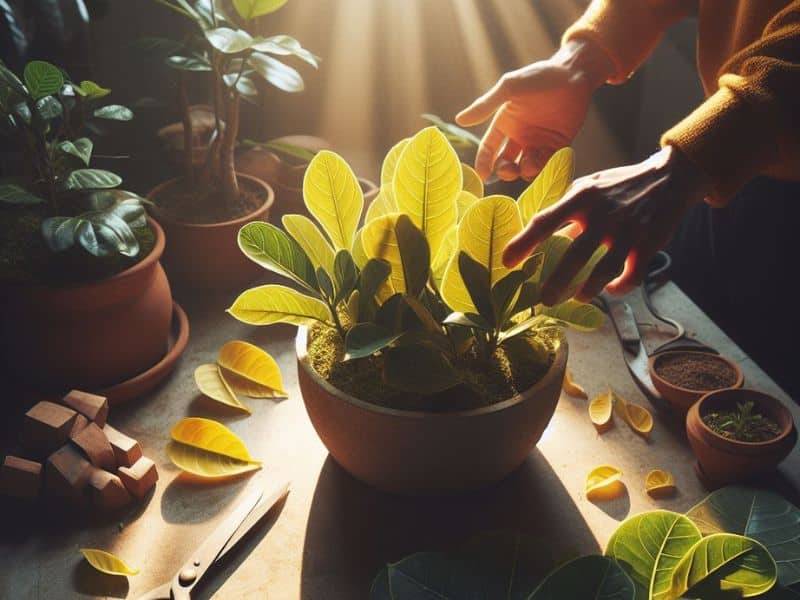
Overwatering Issues
Turning your fiddle leaf fig’s leaves yellow can often scream, “Help, I’m drowning!” Overwatering stands as a common culprit. Your plant’s roots need oxygen as much as they need water.
Flooding them with water cuts off their air supply, leading to root rot and yellow leaves. Scale back on the watering, letting the soil dry out a bit between waterings. Remember, these plants prefer a drink followed by a chance to breathe, not a never-ending flood.
Lack of Nutrients
Yellow leaves may well also wave a flag indicating a nutrient deficit. Fiddle leaf figs thrive on a balanced diet, rich in specific nutrients. If the soil’s as nutrient-packed as a desert, don’t expect lush, green leaves.
Integrate a balanced, slow-release fertilizer into your care routine, especially during the growing seasons of spring and summer. This step could be the game-changer, turning your fiddle leaf fig from lackluster to vibrant.
Pest Infestations
Lastly, invisible invaders could be turning your plant’s leaves yellow. Pests like spider mites, mealybugs, and aphids see your fiddle leaf fig as an all-you-can-eat buffet. These tiny troublemakers suck the life right out of the leaves, leaving them yellow and drained.
They may also cause brown spots on houseplant leaves. Regular leaf checks may help catch these pests in the act. If you find any, a mild washing with neem oil or insecticidal soap can deter the bugs. Remember: a clean plant is a happy plant.
Practical Solutions to Treat Yellow Leaves
Adjusting Watering Habits
Guess what? Your fiddle leaf fig is not a fan of swimming or droughts. Finding the right amount of water is like hitting the jackpot for its health. Ideally, let the top inch of soil dry out before you water again. Overdoing it can drown the roots, while too little leaves them thirsty. Stick to this simple rule, and watch your plant turn a new leaf, quite literally.
Fertilization and Soil Health
Here’s a secret sauce for your fiddle leaf fig: balanced fertilizer. This plant craves nutrients, especially during its growing season in spring and summer. A once-a-month treat with a balanced, all-purpose fertilizer does wonders.
Also, ensuring the soil of fiddle leaf figs drains well yet holds enough moisture balances the nutrition uptake. Like a well-prepared meal, the right mix keeps your plant happy and healthy.
Pest Control Strategies
Uninvited guests, such as pests, love fiddle leaf figs as much as you do. If you spot webs or tiny critters, it’s time for action. Wiping leaves with a neem oil solution helps kick pests to the curb without harsh chemicals. Remember, prevention beats cure, so keeping leaves clean and monitoring for pests regularly keeps your fig fighting fit.
Preventative Measures for Healthy Fiddle Leaf Figs
Ideal Environmental Conditions
Ensuring your fiddle leaf fig thrives starts with giving it a cozy home that mimics its natural habitat as closely as possible. Bright, indirect sunlight is your fig’s best friend, think of it as the plant’s version of a favorite coffee spot – not too hot, not too cold, just perfect.
Furthermore, maintaining a stable temperature between 60-75°F (15-24°C) keeps your plant from throwing a temper tantrum. Drafts are a big no-no; they’re the unexpected guests that can stress out your fiddle leaf fig. Keep these conditions consistent, and you’re on your way to a happy, healthy plant.
Routine Maintenance Tips
Let’s talk about the equivalent of a spa day for your fiddle leaf fig: regular maintenance.
First off, remember to dust those leaves. Yes, it may well sound like a chore, but it’s like clearing the cobwebs for your plant, ensuring it can soak up all that glorious sunlight.
Watering takes a bit of finesse; you’ll want to let the top inch of soil dry out before giving it a drink. Think of it as the plant’s version of “I’m thirsty” – it’ll let you know.
Lastly, don’t forget to feed your green buddy with a balanced fertilizer every few months. Just like you, it needs a balanced diet to grow strong and healthy. Follow these simple steps, and you’ll keep those yellow leaves at bay, turning your fiddle leaf fig into the envy of the plant world.
Frequently Asked Questions
Why do fiddle leaf fig leaves turn yellow?
Fiddle leaf fig leaves turn yellow primarily due to improper watering habits, insufficient or excessive light exposure, and nutrient deficiencies. Other causes include the plant’s natural lifecycle and stress from changing environments.
How can I prevent yellow leaves on my fiddle leaf fig?
Prevent yellow leaves by maintaining ideal environmental conditions like bright, indirect sunlight, stable temperatures, and proper watering techniques. Regularly dusting leaves and feeding your plant with balanced fertilizer are also crucial for prevention.
What should I do if my fiddle leaf fig has yellow leaves?
If your fiddle leaf fig has yellow leaves, adjust your watering habits, ensure it’s receiving adequate sunlight, and use a balanced fertilizer. Additionally, check for pests and treat them as necessary.
Can yellow leaves on a fiddle leaf fig be cured?
Yes, yellow leaves can often be cured by addressing the underlying issues such as adjusting watering schedules, correcting light conditions, and ensuring the plant has the necessary nutrients. However, some leaves may not recover and should be removed.
Is it normal for fiddle leaf figs to have some yellow leaves?
Yes, it’s normal for fiddle leaf figs to have some yellow leaves, especially if it’s part of the plant’s natural aging process. However, a sudden increase in yellow leaves may indicate a problem that needs attention.
Up next: Ivy Leaves Turning Yellow: Identifying Causes and Providing Effective Solutions

